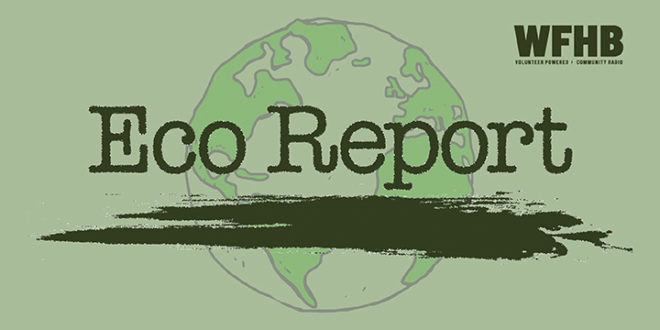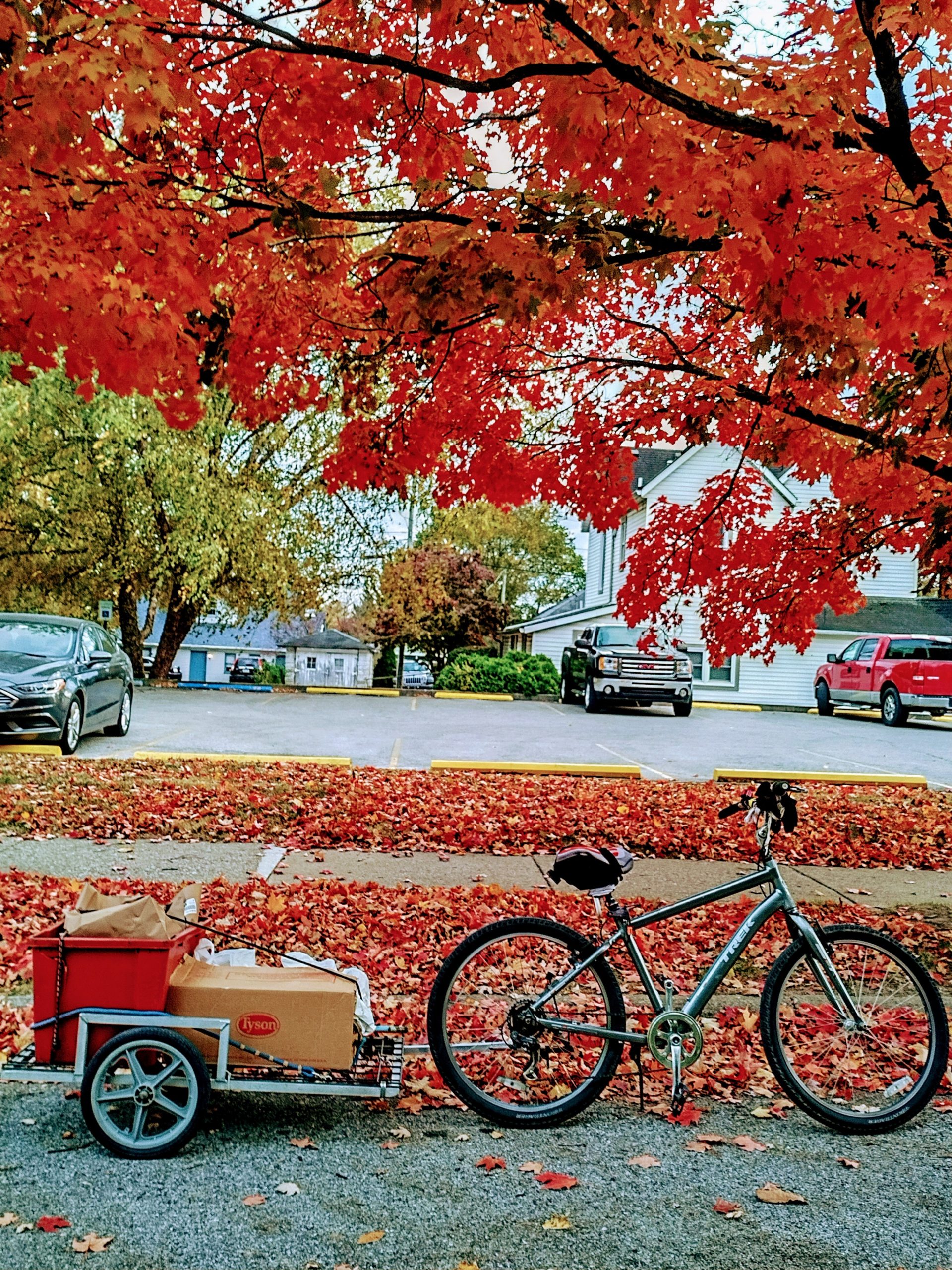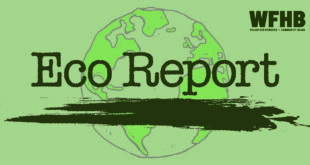Podcast: Play in new window | Download (Duration: 28:46 — 39.6MB)
Subscribe: RSS
| Hello and welcome to Eco-Report. For W-F-H-B, I’m Julianna Dailey. And I’m Frank Marshalek. Today on the program, we have the second half of an interview with Hank Duncan, the City’s Bicycle and Pedestrian Coordinator. Environmental Correspondent Zyro Roze asks Duncan about some of the controversy and safety concerns surrounding alternative modes of transit like the E-scooters currently left at all odd points of town, blocking bike racks and ramps, affecting disability access and serving as a pedestrian hazard. We will hear what the City plans to do about improving the situation. |
|
And now for your environmental reports: The Indiana Department of Environmental Management (IDEM) issued an Air Quality Action Day last weekend for three northeast Indiana counties as high ozone levels. The Indiana Department of Environmental Management issued the AQAD for Allen, Huntington, and Wabash in northeast Indiana. IDEM says anyone who is sensitive to changes in air quality may be affected when ozone levels are high. Children, the elderly, and anyone with heart or lung conditions should avoid exertion or heavy work outside. “Ground-level ozone is formed when sunlight and hot weather combine with vehicle exhaust, factory emissions, and gasoline vapors,” IDEM says. “Ozone in the upper atmosphere blocks ultraviolet radiation, but ozone near the ground is a lung irritant that can cause coughing and breathing difficulties for sensitive populations.” —Norm Holy |
| This year biologists will gain a better perspective on whether the Indiana bat will survive. Last year, healthy colonies were found in Vermont.Wildlife biologists in Vermont discovered a hopeful sign for the state’s Indiana bat population: One colony, located in Hinesburg, just south of Burlington, appears to be flourishing.
In the Green Mountain State and nationwide, bats have been suffering from white-nose syndrome for more than a decade, when the disease first appeared and swiftly decimated the populations of several species. Numbers of Indiana bats in the rest of Vermont have been declining, and the species is federally listed as endangered. But the summer of 2022 colony, located on conserved land in Hinesburg, contained around 700 of the animals, according to data collected this summer by Alyssa Bennett, a small mammals biologist with Vermont’s Department of Fish & Wildlife. The colony hibernates across Lake Champlain in New York, Bennett said. “In Hinesburg last field season, we counted as many as 300 bats in a single roost,” she said. “That is similar to historic numbers at this site, and three times greater than anything we have found in Vermont over the past decade,” when the white-nose disease was first detected in the state. The conserved land in Hinesburg appears to have contributed significantly to the growth of the Indiana bat colony. Habitat there features a mix of shagbark hickory, dead trees with peeling bark, water and transitions where fields turn to forest, according to Bennett. Bat boxes, which are located at the site, may have helped the animals stay warm and conserve energy during the winter. Indiana bats are typically found in the midwestern to eastern United States. Vermont is located at the northeastern edge of its range — the Hinesburg colony is the most northeasterly population of Indiana bats. The colony’s success raises new and hopeful questions about the future of the species in the state, Bennett said. “Are Indiana bats moving further north and east as summers become warmer? Are there other colonies that could benefit from habitat improvement?” she said. “Thanks to last year’s findings, these are the questions we’ll be working to answer this year.” Not all bat populations have made a comeback, however. As the state announced news of the successful Hinesburg colony on Tuesday, the United States Fish & Wildlife Service announced its proposal to nationally list the tricolored bat, whose broad range includes Vermont, as an endangered species due to the ongoing spread of white-nose syndrome. —Norm Holy |
| IndyStar reports that an Indiana manufacturing facility has set a new record, but not in a good way. The subsidiary of British Petroleum (BP) is paying an unprecedented penalty — $40 million — to settle charges its Indiana refinery violated federal law by releasing harmful pollutants into the air and wastewater.
The settlement, between BP, the U.S. Environmental Protection Agency and the Department of Justice, was announced in May. The refinery located near Lake Michigan is one of the oldest and largest in the U.S., with the capacity to process more than 400,000 barrels of crude oil every day. Environmental advocates celebrated the crack down at the refinery with a history of emissions issues. The settlement stems from an October 2019 site visit where inspectors observed multiple violations, according to the Indiana Department of Environmental Management. The federal government’s complaint alleged the refinery violated federal regulations limiting benzene in wastewater streams and hazardous air pollutants. Benzene is a known cancer-causing chemical and air emissions are linked to health problems including difficulty breathing, aggravated asthma, and reduced lung capacity. People residing the Northwest Indiana have 1-2 years lower life expectancy than those living in less polluted parts of Indiana. The settlement obligates BP to pay a penalty of $40 million — the largest civil penalty ever secured for a Clean Air Act settlement for a fixed location. Larger penalties were assessed for vehicle manufacturers for combined emissions violations. —Norm Holy |
| Energy Wire reports a federal court is considering whether to shut down the contested Line 5 pipeline out of concerns that riverbank erosion in Wisconsin could cause a rupture and catastrophic oil spill into Lake Superior and on tribal lands.
Line 5’s opponents say it is not a question of if but when the aging Enbridge Inc. pipeline will be forced to stop operating on its full 645-mile path. Spring flood waters have quickly stripped away feet of riverbank along a bend of the Bad River in Wisconsin near the pipeline’s path, they say. The erosion is not likely to stop there, said the Bad River Band of the Lake Superior Tribe of Chippewa Indians, which is seeking an emergency court order requiring Canada-based Enbridge to purge Line 5 of oil and halt its operation. The pipeline — which moves light crude oil, light synthetic crude and natural gas liquids — runs from Superior, Wis., to Sarnia, Ontario, and crosses approximately 12 miles of the reservation. The segment of the pipeline under question is buried about four feet below the surface, and the amount of riverbank shielding it from exposure is rapidly eroding. The evidence “strongly suggests that further bank loss could be substantial and result in exposure and rupture of the pipeline,” the band said in its motion to the U.S. District Court for the Western District of Wisconsin earlier this month. Judge William Conley, who is likely to issue a ruling on the motion for a permanent injunction in the coming days, signaled in a recent hearing on the motion that he wouldn’t order an immediate shutdown but instead is likely to define riverbank conditions that would force the court to intervene in coming months. —Norm Holy |
| The U.S. Environmental Protection Agency has unveiled a new tool that will help Hoosiers keep track of air pollution, and its sources, across the state.
The ECHO Clean Air Tracking Tool maps information collected from permitted polluters and air monitoring stations. It allows users to find data on emissions and whether the facilities that are creating those emissions are following state and federal laws. The tool also contains information on environmental justice and modeled toxic risk data. ECATT has two main searches: an air monitoring station search that provides data on hazardous air pollutants and criteria air pollutants, and an emissions screener search, which provides data on the emissions sources, including which pollutants they emit and how much they are emitting. To use the tool, search “ECHO air tracking tool” and then “AMS search tutorial.” —Norm Holy |
| With the globe warming by 5 – 9 degrees F over the next 100 years, will temperatures be reached that could kill humans? The data presented here are obtained from an internet search, and the figures rarely specify the role of humidity.
How hot of temperatures is “too hot” for humans? In general, temperatures in the 103°F – 124°F degrees Fahrenheit increase the risk of heat stress and heat-related illness in humans, including death. Any temperature over 125 degrees F can kill within minutes. The lethal range for cattle is 100 degrees Fahrenheit and 80 percent humidity. Because cattle sweat at only 10 percent of the human rate, they are more susceptible to heat stress. 100 degrees and 50 percent humidity is very dangerous for cattle. How hot of temperatures is “too hot” for chickens? In general, temperatures over 90 degrees Fahrenheit increase the risk of heat stress and heat-related illness in chickens, including death. —Norm Holy |

And now, we go to Zyro Roze as he asks Hank Duncan, the City’s Bicycle and Pedestrian Coordinator about the goals of Neighborhood Greenways, also delving into new financial incentives, upcoming regulations and technology like geo_fencing to modify problematic behavior when it comes to the management of Alt Transit Rental Apps that have introduced fleets of electric bikes and scooters to the streets, alleys and sidewalks of Bloomington in recent years.
|
| For Eco Report, I’m Julianna Dailey. And I’m Frank Marshalek.Are you looking for a way to make a difference on environmental issues?
Here at EcoReport we are currently looking for reporters, engineers, and segment producers. Our goal is to report facts on how we’re all affected by global climate disruption and the ongoing assaults on our air, land and water. We also celebrate ecologists, tree huggers, soil builders and an assortment of champions who actively protect and restore our natural world, particularly those who are active in south central Indiana. All levels of experience and all ages are welcome, and we provide the training you’ll need. W-F-H-B also offers internships. To volunteer for Eco-Report, give us a call at (812) 323-1200, or e-mail us at: [email protected]. |
|
And now for some upcoming events: Drop by the Paynetown State Recreation Area at Monroe Lake on Saturday, June 10th, from 2 to 3:30 pm to learn all about Lovely Lunas – the big and beautiful Luna Moth. You will get to see what it looks like as a caterpillar and as the enormous moth. |
| Explore Monroe Lake during a Paddling Trip on Sunday, June 11th, beginning at 7 pm at the Pine Grove State Recreation Area. You must have paddling experience. Learn about the quieter side of Monroe Lake as you watch the sun set and discover beautiful views and hidden wildlife. Sign up at bit.ly/explore-jun11-2023. |
| Beginner Kayaking is taking place at the Paynetown State Recreation Area at Monroe Lake on Tuesday, June 13th, beginning at 10 am. The workshop is designed for beginners where you will learn basic paddling and safety skills. You will have practice time and kayaks, paddles and life jackets are all provided. |
| What in the world is a Snot Otter? Learn all about the endangered Snot Otter found in Indiana at Spring Mill State Park on Wednesday, June 14th, from 3 to 3:30 pm. You will get to make some slime and meet Sydney, the Snot Otter at the Lakeview Activity Center. |
| Enjoy a Sunset Paddle at Griffy Lake Nature Preserve on Thursday, June 15th, from 8:30 to 10 pm. Experience the sunset on Griffy Lake as you take in the sites and sounds of the evening. Register at bloomington.IN.gov/parks. |
| And that wraps up our show for this week. EcoReport is brought to you in part by M-P-I Solar, a Bloomington business specializing in solar hot water, solar electricity and solar hot air systems. M-P-I Solar designs and installs solar power generation systems that encourage independence and individual responsibility. Found locally at 812-334-4003 and on the Web at M-P-I solar energy dot com. |
| This week’s headlines were written by Norm Holy. Today’s news feature was produced by Zyro Roze and edited by Noelle Herhusky-Schneider. Julianna Dailey assembled the script which was edited by Zyro Roze. Julianna Dailey compiled our events calendar. Kade Young and Noelle Herhusky-Schneider produced today’s show. Branden Blewett was our engineer.
For W-F-H-B, I’m Julianna Dailey. And I am Frank Marshalek. And this is EcoReport. |
 WFHB Bloomington Community Radio
WFHB Bloomington Community Radio



